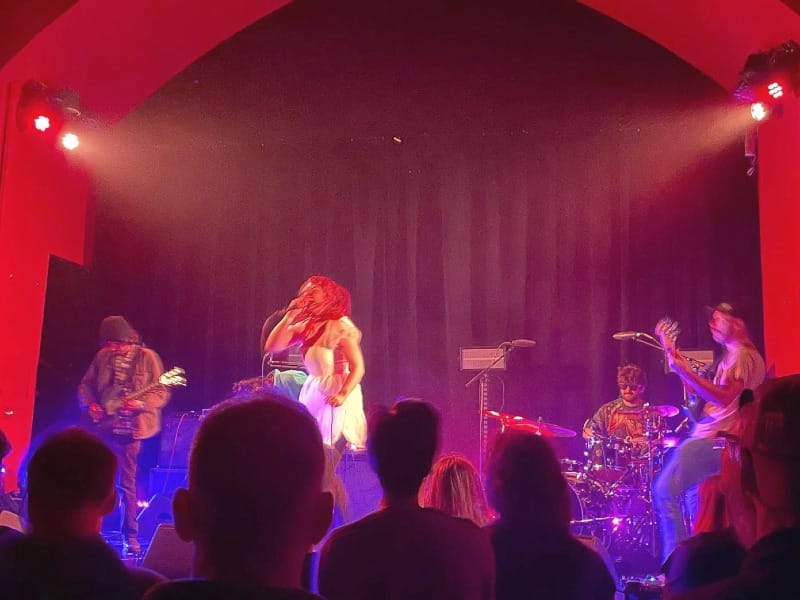Allow Me to Troubleshoot
On Guerilla Toss, Jlin, and some quirked-up white boys

Guerilla Toss @ The Chapel
San Francisco, CA
October 29, 2023
Like other screenings across the country, my Sunday matinee showing of the 40th anniversary re-release of the Talking Heads concert film Stop Making Sense got pretty lit, the largely (but not entirely) older audience dancing in the aisles, bopping in the recliners, and cheering in tandem with the on-screen crowd. Twitter celebrated this classic artifact of quirked-up white boy excellence by recirculating old footage of David Byrne privately workshopping his anti-Jagger lurches and Squidward wiggles. The film endures for its irresistible rhythm and jocularity but is iconic for its arresting strangeness, Byrne serving as both its confused protagonist and knowing ringleader. Twitter being what it is, there was also unkind reconsideration of LCD Soundsystem as the heir to the throne of New York dance rock, staged on the reliably enriching and productive war grounds of generational conflict. James Murphy’s project is certainly the equivalent commercial juggernaut, and he has been forthright about working under a staggering array of neuroses, but on stage he is a reliable party inciter, every bit a professional DJ fronting a rock band. For irresistible rhythm and crucial weirdness carried on in the Byrne tradition, there should be much greater consideration of Guerilla Toss.
What impresses most about Guerilla Toss is their polyvalence, the band casually deploying numerous stylistic satellites around a gravitational core of clamoring dance rock. Starting with early releases on NNA Tapes and Feeding Tube, in particular the wonderfully mangled Gay Disco LP, Guerilla Toss slung manic shrieks, wonky riffs and hostile cowbell in busted but decisively danceable time signatures, making good on multiple threads of the east coast punk lineage: no wave, new wave, and high-brow downtown art rock. They soon moved toward actual disco, first with the Flood Dosed cassette EP and later three full-lengths that, while flexing a firm punk physique, integrated long-form structures, sparkling synths and glamorous dancefloor melodies amid the carnage. All these releases were appropriately shepherded by DFA Records until, reportedly, James Murphy cleaned house due to sinking financials.
The band’s new record for Sub Pop, Famously Alive, introduces the hyperpop palette as a logical expansion of the band’s formidable capabilities, and it blooms with shining, squelching maximalism. Once a gleeful inciter of mayhem, singer Kassie Carlson’s lyrics have turned reflective and life-affirming. Her elastic vocal timbre has fit the band’s every whim to date, and on the album it lends itself to any and all demented FX chains: pinchy squeaks, infinity reverbs, vocoder bitcrush, and absurdly dense layers of backing harmony. Catching them for my third time, I was hoping to hear this dexterity at the Chapel. And I only sort of did—the mic was too quiet.
Maybe this is a good moment to get at my motivations for starting a blog about live music. Post-COVID, post-Astro World, and in an environment where musicians largely live on tour income, I find the live music review an interesting and worthy form at this moment in time, one I thought might be due for a resurgence. A great many musicians successfully build audiences through excellent work on stage, but that excitement is primarily harnessed through word-of-mouth and unseen industry machinations. A breakthrough album, though not without its own quiet cascade of back-channel dealings, at least comes with a corresponding definitive critical event–a wave of splashy reviews, a Best New Music. There is nothing close to that for live performance, even though a club ticket costs as much or more than a vinyl LP. In the musical theater world, this works nearly in reverse: an original cast recording is a significant and lucrative node of fan engagement–possibly the only experience people in certain parts of the country can access–while being almost totally irrelevant to the critical evaluation of a production. The gig, and its normalized return to our lives, deserves more reverence.
I've identified a few problems, of course. The biggest one being that as of late, reporting of this nature only gets clicks if it pertains to the biggest of spectacles or involves the artist getting hit with a projectile. Forty years after the rather large suit, theatrical release of a concert film is limited to artists who earn tour revenue equivalent to the GDP of Belarus, mostly to service people in certain tax brackets who couldn’t get tix. My concerns for this blog are a little more practical: I can arrive wide-eyed to the club, my talking points holstered, only to be easily thwarted by something as trifling as an errant cable, a pesky resonance, or, in the case of Guerilla Toss, a mild obfuscation of the vocals. Disappointing! And for you, live music newsletter reader, incredibly boring to read! What else could I say in this situation?
If ever a bad mix might correspond to a larger narrative, it would do so entirely by accident. In 2018, I saw the producer Jlin perform an exuberantly received set at The Lab, a white wall performance space in San Francisco’s Mission district. This was shortly after the release of the marvelous Black Origami, a record of dazzling rhythmic fortitude constructed from the staggered shuffle templates of Chicago footwork. Jlin's compositions are so immense and martial, not a single early press clip failed to mention her prior employment at a Gary, Indiana steel mill. Plenty of those at The Lab submitted hips and shoulders to the songs’ kinetic rush, but just as many stood still to admire their heavily wrought latticework.
A year later, she played a side room in a massive SOMA dance club where for the first 20 minutes, the speakers produced no low end. Shit! Eyes fixed on her Ableton Push, Jlin betrayed no emotion, enduring the probing flashlight of a house mixing engineer struggling to troubleshoot. But when she got off stage, she could barely conceal her disappointment. Now entirely facing the prestige art world, Jlin recently soundtracked a modern dance production and earned a Pulitzer nomination for a collaboration with Third Coast Percussion ensemble. The distance between her rhythmic acumen and the ethos of the dance club is greater than ever, the province of footwork no longer containing her ambitions.
Back at the Chapel, there was no tidy narrative forthcoming. It wasn’t that Carlson’s vocals were totally inaudible—I heard her cozy up with the effects array like a playmate, a cybernetic secondary self—just relegated to merely another input when they should’ve been the center of the action, like any ringleader. Byrne had said the choreography he prepared for Stop Making Sense aimed to fully avoid the “body vocabulary” of rock singers. Carlson is not dancing with a lamp, but her thrashing and heaving doesn’t have anything to do with Jagger-esque self-deification, giving everyone else in the audience permission to let their appendages speak outside convention.
For all their formal excellence, what has remained consistent is that Guerilla Toss resist the clean-cut or high-brow. For every anthemic pop track, there was a stray Beefheart passage or extra-terrestrial synth wheeze. Sometimes the bass sounded gold-plated, other times covered in green slime. Despite having never lost their edge, they appear to be doing quite well with largely (but not entirely) older crowds. They opened a leg of last year’s Pavement reunion tour and here served as the warm-up for Karina Rykman, a New England psych bassist who's been co-produced by Trey Anastasio of Phish. I would prefer Guerilla Toss not entertain the idea of a jam band pivot, but considering their unimpeachable track record, perhaps I’m just nervous that I might come to like it. As the Talking Heads did 40 years ago, Guerilla Toss succeed, amid familiar and compelling rhythms, to consistently bewilder.

